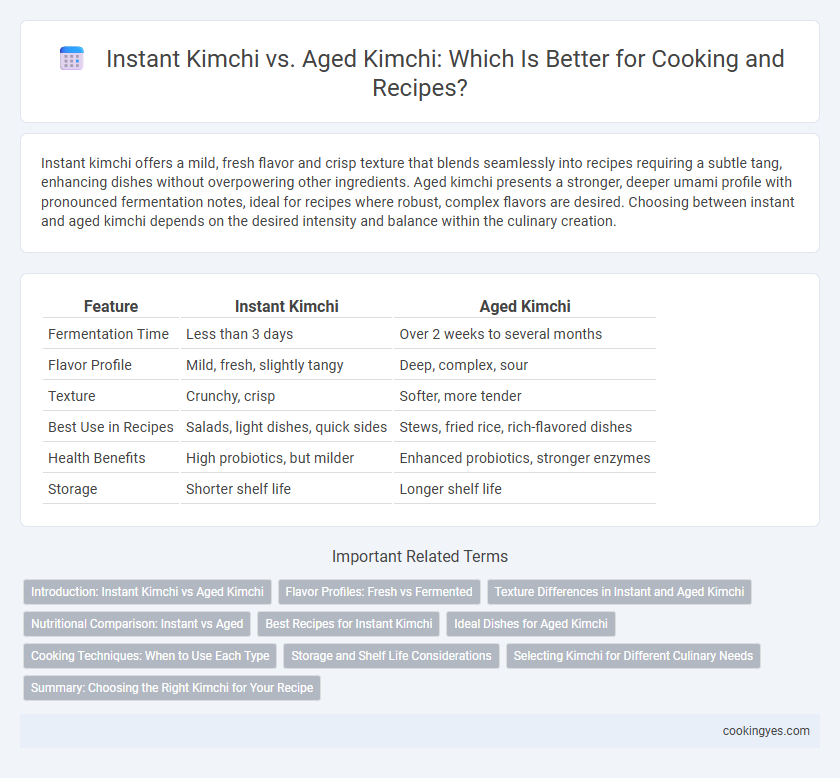Instant kimchi offers a mild, fresh flavor and crisp texture that blends seamlessly into recipes requiring a subtle tang, enhancing dishes without overpowering other ingredients. Aged kimchi presents a stronger, deeper umami profile with pronounced fermentation notes, ideal for recipes where robust, complex flavors are desired. Choosing between instant and aged kimchi depends on the desired intensity and balance within the culinary creation.
Table of Comparison
| Feature | Instant Kimchi | Aged Kimchi |
|---|---|---|
| Fermentation Time | Less than 3 days | Over 2 weeks to several months |
| Flavor Profile | Mild, fresh, slightly tangy | Deep, complex, sour |
| Texture | Crunchy, crisp | Softer, more tender |
| Best Use in Recipes | Salads, light dishes, quick sides | Stews, fried rice, rich-flavored dishes |
| Health Benefits | High probiotics, but milder | Enhanced probiotics, stronger enzymes |
| Storage | Shorter shelf life | Longer shelf life |
Introduction: Instant Kimchi vs Aged Kimchi
Instant kimchi offers a fresher, milder flavor ideal for quick recipes and salads, while aged kimchi provides a deeper, tangier taste that enhances stews and fermented dishes. The fermentation process in aged kimchi develops complex probiotics and rich umami, crucial for traditional Korean cuisine. Choosing between instant and aged kimchi depends on recipe requirements for texture, acidity, and flavor intensity.
Flavor Profiles: Fresh vs Fermented
Instant kimchi offers a crisp, fresh flavor with bright, tangy notes that enhance recipes requiring a clean, vibrant taste profile. Aged kimchi provides a deep, complex umami intensity and sourness developed through extended fermentation, ideal for dishes seeking rich, pungent flavors. Selecting between instant and aged kimchi depends on the desired balance of freshness versus fermented depth in culinary applications.
Texture Differences in Instant and Aged Kimchi
Instant Kimchi features a crisp and fresh texture due to its minimal fermentation time, making it ideal for recipes requiring a crunchy bite. Aged Kimchi has a softer, more tender texture with complex, developed flavors from extended fermentation, enhancing dishes that benefit from rich umami notes. The choice between instant and aged kimchi significantly impacts the mouthfeel and flavor profile in Korean cooking.
Nutritional Comparison: Instant vs Aged
Instant kimchi retains higher levels of vitamin C and fresh probiotics due to minimal fermentation time, offering a crisp texture and bright flavor ideal for quick recipe inclusion. Aged kimchi undergoes extended fermentation, increasing beneficial lactic acid bacteria and enhancing levels of B vitamins and antioxidants, which contribute to improved gut health and complex flavor profiles. Nutritionally, aged kimchi provides more potent probiotics and antioxidant benefits, while instant kimchi offers a fresher nutrient profile with higher vitamin C content.
Best Recipes for Instant Kimchi
Instant kimchi offers a fresher, milder taste ideal for quick recipes like kimchi fried rice, kimchi pancakes, and spicy kimchi stews where crunch and subtle flavors enhance the dish. Its shorter fermentation time preserves the crisp texture and vibrant probiotics beneficial for digestive health. Using instant kimchi allows for vibrant, tangy flavor integration without the overpowering sourness found in aged kimchi, making it perfect for fast-paced cooking and balanced flavor profiles.
Ideal Dishes for Aged Kimchi
Aged kimchi delivers a robust, tangy flavor profile that enhances stews like kimchi jjigae and spicy soups, enriching them with deep umami complexity. Its softened texture allows it to blend seamlessly into savory pancakes (kimchi jeon) and fried rice, absorbing heat and transforming dishes with intense fermented notes. Incorporating aged kimchi in slow-cooked recipes brings out its matured acidity, making it ideal for braises and hearty casseroles.
Cooking Techniques: When to Use Each Type
Instant kimchi offers a fresh, crunchy texture ideal for quick-cooking dishes like stir-fries and soups where a bright, tangy flavor enhances the recipe without overpowering other ingredients. Aged kimchi, with its deep, fermented complexity and softer consistency, excels in slow-cooked stews and braises, providing rich umami notes that develop further during long cooking times. Choosing between instant and aged kimchi depends on the cooking technique and desired flavor intensity, ensuring optimal integration into Korean and fusion recipes.
Storage and Shelf Life Considerations
Instant kimchi offers convenience with a shorter fermentation period, making it ideal for recipes requiring a mild, fresh flavor and a shorter shelf life of about 1-2 weeks when refrigerated. Aged kimchi undergoes extended fermentation, developing a deeper, more complex taste and can be stored for several months under proper refrigeration, enhancing recipes that benefit from robust, tangy notes. Storage methods directly impact shelf life and flavor profile, with airtight containers and consistent refrigeration critical for preserving optimal texture and taste in both types.
Selecting Kimchi for Different Culinary Needs
Instant kimchi offers a fresh, mildly tangy flavor with a crisp texture ideal for recipes requiring subtle fermentation notes, such as salads or light stir-fries. Aged kimchi provides a deeper, more pungent taste and softer consistency perfect for hearty dishes like stews, kimchi fried rice, and braises where bold flavors enhance the overall profile. Selecting kimchi based on fermentation duration ensures optimal flavor balance and texture suited to diverse culinary applications.
Summary: Choosing the Right Kimchi for Your Recipe
Instant kimchi offers a crisp texture and milder, fresher flavor ideal for salads and quick dishes, while aged kimchi provides a deeper, tangier taste perfect for stews and traditional recipes. The fermentation level significantly affects the sourness and complexity, influencing the dish's overall profile. Selecting between instant and aged kimchi depends on desired flavor intensity and cooking time in the recipe.
Instant Kimchi vs Aged Kimchi for Recipe Inclusion Infographic

 cookingyes.com
cookingyes.com